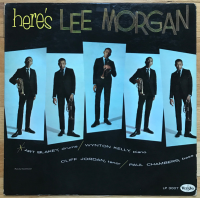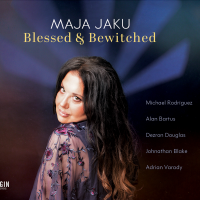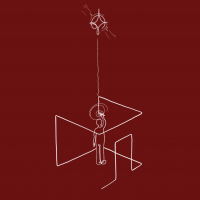Home » Jazz Musicians » Lee Morgan
Lee Morgan
Lee Morgan was a jazz prodigy, joining the Dizzy Gillespie big band at 18, remaining a member for two years. Beginning in 1956, he began recording as a leader, mainly for the Blue Note label, eventually he recorded twenty-five albums for the company. Morgan's principal influence as a player was Clifford Brown, having had direct contact with him before Brown's premature death.
He was also a featured sideman on several early Hank Mobley records, and John Coltrane's Blue Train. On the latter LP, he even played a bent-up horn like Gillespie's. Joining Art Blakey's Jazz Messengers in 1958 further developed his talent as a soloist and writer. He toured with Blakey for a few years, and was featured on Moanin, which is probably Blakey's best known recording. When Benny Golson left the Jazz Messengers, Morgan persuaded Blakey to hire Wayne Shorter, a young tenor saxophonist, to fill the chair. This classic version of the Jazz Messengers, including Bobby Timmons and Jymie Merritt would record the classic The Freedom Rider album.
Morgan tried to move in to the more advanced areas of the music in the early 1960s. He left the Jazz Messengers in 1961, struggling with heroin addiction, managing to kick his habit in his hometown. He returned to the music scene after a two-year absence, playing on Grachan Moncur III's essentially avant-garde Evolution album (his favourite work), and experimenting on some of his own recordings such as the title track of Search for the New Land (1964), but the popularity of his famous album, The Sidewinder, featuring Joe Henderson precluded his career developing in this way.
The title track of that record cracked the pop charts in 1964 and served as the background theme for Chrysler commercials during the World Series. The Sidewinder's crossover success in a rapidly changing pop music market caused Blue Note to rush the track's "Boogaloo" sound to market. This is evidenced in the mid-60s output of many Blue Note stars, including Morgan, and some of the lesser artists in the stable, releasing albums with modified and rythmically punchy blues tracks, such as "Yes I Can, No You Can't" on Morgan's own The Gigolo. In 1964 Morgan rejoined the Jazz Messengers, after his successor Freddie Hubbard departed, which had now become a sextet with the addition of Curtis Fuller to the group.
Alongside this commercial success, Morgan continued to record prolifically, producing such works as Search For the New Land which reached the top 20 of the R&B charts. His work became increasingly more modal and free towards the end of the sixties. He had begun to lead his own group, featuring Bernie Maupin as a multi-reedist.
Read moreTags
Lee Morgan: Here's Lee Morgan

by C. Andrew Hovan
While Craft Recordings' new OJC reissue series has largely drawn from its treasure trove of Prestige and Riverside titles, the label recently expanded its scope to include two standout jazz albums from Chicago's historic Vee-Jay Records. Founded in 1953 by husband-and-wife team James Bracken and Vivian Carter, Vee-Jay was not only one of the earliest Black-owned and woman-owned labels but also a remarkably eclectic imprint. Known for its blues releases--and even some early Beatles records--Vee-Jay also documented top-tier ...
Continue ReadingBack In The Groove: Material Matters

by Tarik Townsend
An aspect of jazz that is often overlooked is the material. That is, the very tunes that the musicians are performing. Arguably more important than the key or the tempo, the song itself dictates where the musician's inspiration will go, and even that isn't always a sure thing. They're a launching pad and an indicator of an artist's imagination. The material can also lead the players into some fascinating places normally not tread by anyone else--including themselves. Some recent records ...
Continue ReadingTop Ten Lee Morgan Recordings

by Jason Innocent
These albums represent a diverse range of Lee Morgan's musical output and showcase his virtuosity, innovation, and contribution to jazz trumpet. The Sidewinder Blue Note Records 1963 Morgan's most famous and commercially successful release is this album. It features the catchy title track, which became a major hit and is now considered a jazz standard. Cornbread Blue Note Records 1965 This album showcases Morgan's exceptional ...
Continue ReadingThe Blue Note Label

by Jerome Wilson
This show, from July 2021, covers two hours worth of the extensive legacy of the Blue Note record label, examining some of the label's rich past as well as its present. The program goes all the way from Lee Morgan and Bud Powell to Joel Ross and Ambrose Akinmusire. Playlist Henry Threadgill Sextett “I Can't Wait Till I Get Home" from The Complete Novus & Columbia Recordings of Henry Threadgill & Air (Mosaic) 00:00 Thelonious Monk “In Walked ...
Continue ReadingDefinitive Article Lee

by Patrick Burnette
Many moons ago on Episode 95 we did an podcast devoted to Freddie Hubbard, so in honor of the new Complete at the Lighthouse release, we thought it was time to do one for Lee Morgan But not to discuss Live at the Lighthouse because that's the way we roll. (Look me up on Facebook if you have questions about that release). We survey the trumpet master's brutally truncated career and ponder what might have been while enjoying one of ...
Continue ReadingHard Bop: Ten Essential Live Albums

by Chris May
"Fire! That's what people want. Music is supposed to wash away the dust of everyday life. You're supposed to make them turn around, pat their feet. That's what jazz is about. Play with fire. Play from the heart, not from your brain. You got to know how to make the two meet." So said drummer and hard bop pioneer Art Blakey in an interview with David Rosenthal in the 1980s. To which his partner in funk, the ...
Continue ReadingJoe Henderson: The Complete Joe Henderson Blue Note Studio Sessions

by Scott Gudell
If an artist stamps his jazz passport with any one of these labels--Blue Note, Verve, Milestone--it's pretty much a guarantee that you've arrived in style. Tenor saxophonist Joe Henderson has traveled with all three and more. The 2021 reissue from the prestigious Mosaic Records focuses on Henderson's 1960s tenure with Blue Note offers a new opportunity to experience an abundance of rich and creative jazz from the decade. Big band and bop were duking it out in the ...
Continue ReadingJazz Musician of the Day: Lee Morgan

Source:
Michael Ricci
All About Jazz is celebrating Lee Morgan's birthday today!
Morgan was a jazz prodigy, joining the Dizzy Gillespie big band at 18, remaining a member for two years. Beginning in 1956, he began recording as a leader, mainly for the Blue Note label, eventually he recorded twenty-five albums for the company. Morgan's principal influence as a player was Clifford Brown, having had direct contact with him before Brown's premature death. He was also a featured sideman on several early Hank ...
read more
Jazz Musician of the Day: Lee Morgan

Source:
Michael Ricci
All About Jazz is celebrating Lee Morgan's birthday today!
Morgan was a jazz prodigy, joining the Dizzy Gillespie big band at 18, remaining a member for two years. Beginning in 1956, he began recording as a leader, mainly for the Blue Note label, eventually he recorded twenty-five albums for the company. Morgan's principal influence as a player was Clifford Brown, having had direct contact with him before Brown's premature death. He was also a featured sideman on several early Hank ...
read more
Jazz Musician of the Day: Lee Morgan

Source:
Michael Ricci
All About Jazz is celebrating Lee Morgan's birthday today!
Morgan was a jazz prodigy, joining the Dizzy Gillespie big band at 18, remaining a member for two years. Beginning in 1956, he began recording as a leader, mainly for the Blue Note label, eventually he recorded twenty-five albums for the company. Morgan's principal influence as a player was Clifford Brown, having had direct contact with him before Brown's premature death. He was also a featured sideman on several early Hank ...
read more
Jazz Musician of the Day: Lee Morgan

Source:
Michael Ricci
All About Jazz is celebrating Lee Morgan's birthday today!
Morgan was a jazz prodigy, joining the Dizzy Gillespie big band at 18, remaining a member for two years. Beginning in 1956, he began recording as a leader, mainly for the Blue Note label, eventually he recorded twenty-five albums for the company. Morgan's principal influence as a player was Clifford Brown, having had direct contact with him before Brown's premature death. He was also a featured sideman on several early Hank ...
read more
Jazz Musician of the Day: Lee Morgan

Source:
Michael Ricci
All About Jazz is celebrating Lee Morgan's birthday today!
Morgan was a jazz prodigy, joining the Dizzy Gillespie big band at 18, remaining a member for two years. Beginning in 1956, he began recording as a leader, mainly for the Blue Note label, eventually he recorded twenty-five albums for the company. Morgan\'s principal influence as a player was Clifford Brown, having had direct contact with him before Brown\'s premature death... Read more.
Place our Musician of the Day widget on ...
read more
Electrifying Track: Heavy Dipper

Source:
JazzWax by Marc Myers
In September 1957, trumpeter Lee Morgan recorded his album The Cooker with baritone saxophonist Pepper Adams, pianist Bobby Timmons, bassist Paul Chambers and drummer Philly Joe Jones. Heavy Dipper is a Morgan original. It's a light, high-stepping tune that alternates between minor and major keys and has plenty of snap. Everyone in the quintet gets a chance to solo. This was a rare pairing of Morgan and Adams, who recorded most often with trumpeter Donald Byrd. Interestingly, Morgan, Chambers and ...
read more
Jazz Musician of the Day: Lee Morgan

Source:
Michael Ricci
All About Jazz is celebrating Lee Morgan's birthday today!
Morgan was a jazz prodigy, joining the Dizzy Gillespie big band at 18, remaining a member for two years. Beginning in 1956, he began recording as a leader, mainly for the Blue Note label, eventually he recorded twenty-five albums for the company. Morgan\'s principal influence as a player was Clifford Brown, having had direct contact with him before Brown\'s premature death... Read more.
Place our Musician of the Day widget on ...
read more
Jazz Musician of the Day: Lee Morgan

Source:
Michael Ricci
All About Jazz is celebrating Lee Morgan's birthday today!
Morgan was a jazz prodigy, joining the Dizzy Gillespie big band at 18, remaining a member for two years. Beginning in 1956, he began recording as a leader, mainly for the Blue Note label, eventually he recorded twenty-five albums for the company. Morgan\'s principal influence as a player was Clifford Brown, having had direct contact with him before Brown\'s premature death... Read more.
Place our Musician of the Day widget on ...
read more
Lee Morgan: I Called Him Morgan

Source:
JazzWax by Marc Myers
Jazz is the only form of American music that comes with a built-in film noir. As a nocturnal sub-culture, jazz has its own language, its own style and its own cynical way of looking at the world. Along the way, the 100-year-old jazz story has amassed dozens of secrets and unsolved mysteries. What happened the night Chu Berry died in a car crash in Ohio? What exactly happened to Lester Young while he was incarcerated for drug possession in an ...
read more
































































.jpg)



















